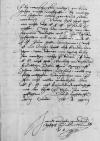Wir haben jestriges thagess E(wer) F(urstlichen) D(urchlauch)t cf. Albrecht I von Hohenzollern-Ansbach to Ioannes DANTISCUS Königsberg, 1538-10-21, CIDTC IDL 6323⌊schreÿbencf. Albrecht I von Hohenzollern-Ansbach to Ioannes DANTISCUS Königsberg, 1538-10-21, CIDTC IDL 6323⌋ von der selbten dÿner entpfangen / und mit whemutigem hertzen dass jennige, so E(wer) D(urchlauch)t auss gemeÿnnem(m) geruchte erfharn, / gelesen. / Sein doch der hoffnung zu Gotthe, / dyweÿl von ko(nigliche)n hove nichts der gleichen wirde angetzeÿgt, / dass im kortzen wass bessers wirt ankomen. / Es hatt auch E(wer) F(urstliche) D(urchlauch)t furstlich und wolgethan zu schickenn(n), umb gruntliche wÿssenheÿtt zu habenn(n), / der wir mit sondrem(m) vleÿs dancken, / das dÿ uns solchs nicht hat woldt bergen, / und gedachten ÿren dÿner, / so wir wass zu schreÿben gesintt, / an unss lassen gelangen(n), / hirumb so halde wir auch eÿnnen bothen(n) uff dÿ farth, / so der gleichen unss wass vor kompt, / den an al sewmen(n) an ko(nigliche)n hoff abzuferthigen, / und dennoch doruff warthen, / ab sich dis geruchte sterker thett machen, / das E(wer) F(urstliche) D(urchlauch)t  GStA, PK, HBA, C 1, No 526, f. 2 unnumbered ( so dy was e schreÿben wolthe ) ÿre brive hieher mechte vorschaffen, / dÿ welche mit sycherem vleis geantwurt sollen werden etc. Newes dyse zeÿt hab wir nichts, dass E(wer) F(urstliche) D(urchlauch)t zu stunde zu wÿssen, / wÿ der Walache von den seÿnnenn vorlassen, und dÿ zum The Ottoman Turks (Turcae) ⌊ThurkenThe Ottoman Turks (Turcae) ⌋ gefhallenn, und er vortrÿbenn(n), / wirdt E(wer) F(urstliche) D(urchlauch)t zuvor haben vornhomen. / Unss ÿst nun lange zeÿtt auss fremden orthern, / von dannen wir teglich brive sein warthen, / nichts zu komen(n). / Ist, das E(wer) D(urchlauch)t wass hatt, / nemlich von unserm(m) freuntlichen, lyben hern probably Johann Albrecht of Brandenburg-Ansbach (Johann Albrecht von Hohenzollern) (*1499 – †1550), son of Friedrich V, Margrave of Brandenburg and Sophia, daughter of Casimir IV Jagiellon, King of Poland; brother of Albrecht I von Hohenzollern Duke in Prussia; 1545-1550 archbishop of Magdeburg and bishop of Halberstadt ⌊marggraff Iohans Albrechtenprobably Johann Albrecht of Brandenburg-Ansbach (Johann Albrecht von Hohenzollern) (*1499 – †1550), son of Friedrich V, Margrave of Brandenburg and Sophia, daughter of Casimir IV Jagiellon, King of Poland; brother of Albrecht I von Hohenzollern Duke in Prussia; 1545-1550 archbishop of Magdeburg and bishop of Halberstadt ⌋, / auch sunst, / wolde uns solchs mÿttheÿlen, / dergleichen wir zu thun nicht wollen underlassen, / dan E(wer) F(urstliche) D(urchlauch)t vÿl freundtdinstwÿllicheÿtt mit der thatt zu thun / sein wir geflyssenn. /
GStA, PK, HBA, C 1, No 526, f. 2 unnumbered ( so dy was e schreÿben wolthe ) ÿre brive hieher mechte vorschaffen, / dÿ welche mit sycherem vleis geantwurt sollen werden etc. Newes dyse zeÿt hab wir nichts, dass E(wer) F(urstliche) D(urchlauch)t zu stunde zu wÿssen, / wÿ der Walache von den seÿnnenn vorlassen, und dÿ zum The Ottoman Turks (Turcae) ⌊ThurkenThe Ottoman Turks (Turcae) ⌋ gefhallenn, und er vortrÿbenn(n), / wirdt E(wer) F(urstliche) D(urchlauch)t zuvor haben vornhomen. / Unss ÿst nun lange zeÿtt auss fremden orthern, / von dannen wir teglich brive sein warthen, / nichts zu komen(n). / Ist, das E(wer) D(urchlauch)t wass hatt, / nemlich von unserm(m) freuntlichen, lyben hern probably Johann Albrecht of Brandenburg-Ansbach (Johann Albrecht von Hohenzollern) (*1499 – †1550), son of Friedrich V, Margrave of Brandenburg and Sophia, daughter of Casimir IV Jagiellon, King of Poland; brother of Albrecht I von Hohenzollern Duke in Prussia; 1545-1550 archbishop of Magdeburg and bishop of Halberstadt ⌊marggraff Iohans Albrechtenprobably Johann Albrecht of Brandenburg-Ansbach (Johann Albrecht von Hohenzollern) (*1499 – †1550), son of Friedrich V, Margrave of Brandenburg and Sophia, daughter of Casimir IV Jagiellon, King of Poland; brother of Albrecht I von Hohenzollern Duke in Prussia; 1545-1550 archbishop of Magdeburg and bishop of Halberstadt ⌋, / auch sunst, / wolde uns solchs mÿttheÿlen, / dergleichen wir zu thun nicht wollen underlassen, / dan E(wer) F(urstliche) D(urchlauch)t vÿl freundtdinstwÿllicheÿtt mit der thatt zu thun / sein wir geflyssenn. /
 GStA, PK, HBA, C 1, No 526, f. 3 unnumbered
GStA, PK, HBA, C 1, No 526, f. 3 unnumbered  GStA, PK, HBA, C 1, No 526, f. 1 unnumbered
GStA, PK, HBA, C 1, No 526, f. 1 unnumbered  GStA, PK, HBA, C 1, No 526, f. 2 unnumbered ( so dy was e schreÿben wolthe ) ÿre brive hieher mechte vorschaffen, / dÿ welche mit sycherem vleis geantwurt sollen werden etc. Newes dyse zeÿt hab wir nichts, dass E(wer) F(urstliche) D(urchlauch)t zu stunde zu wÿssen, / wÿ der Walache von den seÿnnenn vorlassen, und dÿ zum
GStA, PK, HBA, C 1, No 526, f. 2 unnumbered ( so dy was e schreÿben wolthe ) ÿre brive hieher mechte vorschaffen, / dÿ welche mit sycherem vleis geantwurt sollen werden etc. Newes dyse zeÿt hab wir nichts, dass E(wer) F(urstliche) D(urchlauch)t zu stunde zu wÿssen, / wÿ der Walache von den seÿnnenn vorlassen, und dÿ zum 

